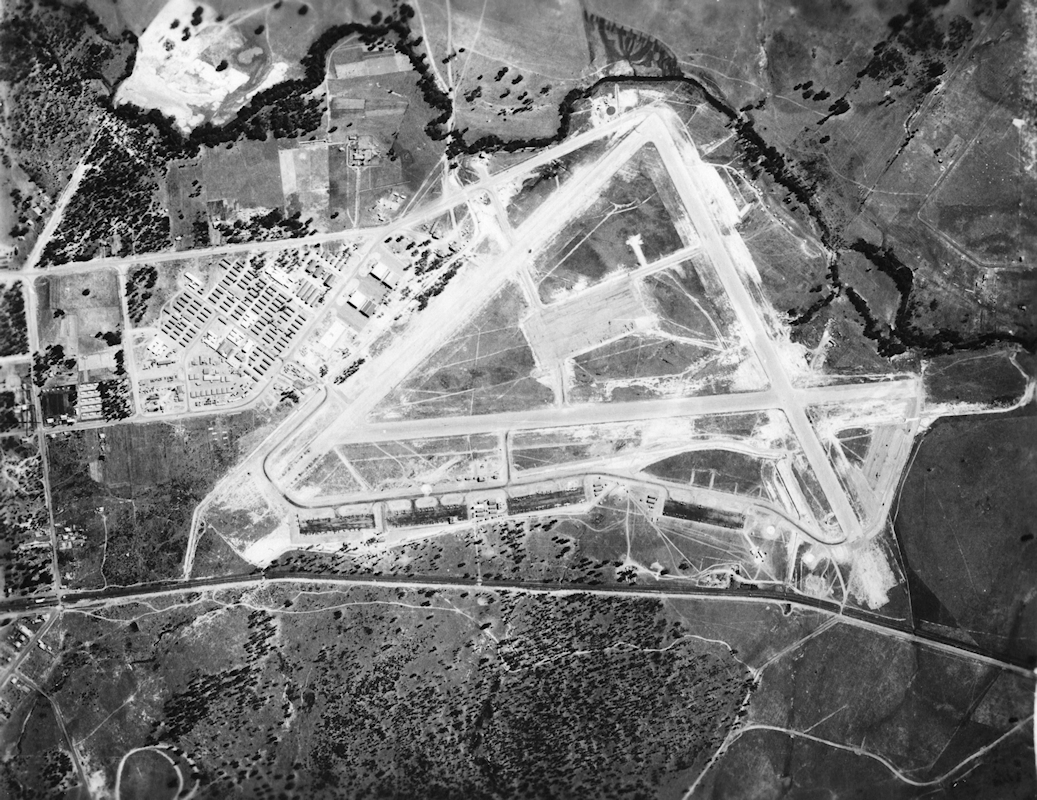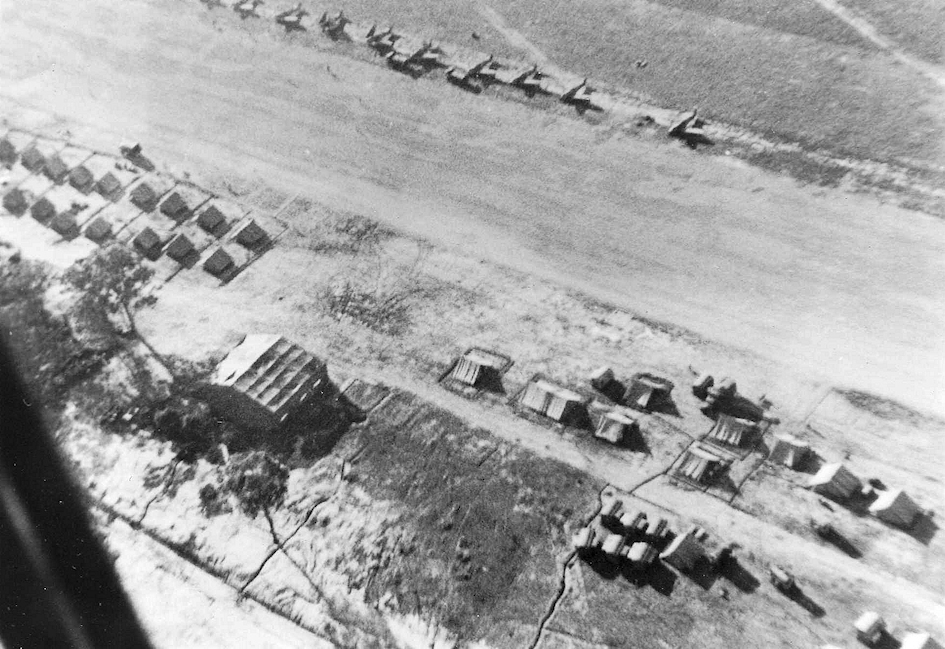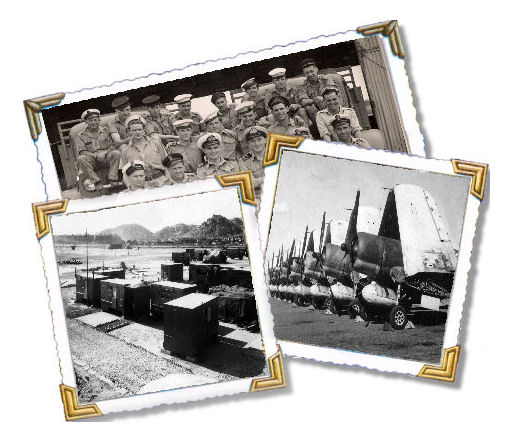Mobile Naval Air Base No. III
Assembly and commissioning in the UK
Personnel and equipment for Mobile Naval Air Base III began to assemble at Royal Naval Air Station Ludham, Norfolk the headquarters of the Mobile Naval Airfields Organisation (MNAO) from October 18th 1944. The unit was to form as a type A (Small) MONAB tasked with supporting up to 50 aircraft and was allocated the following maintenance components:
Mobile Maintenance (MM) unit No. 2 supporting Corsair Mk.II & IV, Hellcat Mk.I & II, Seafire Mk.III
Maintenance Servicing (MS) unit No. 3 supporting Firefly Mk.I
Maintenance Servicing (MS) unit No. 4 supporting Seafire Mk.III
(see MONAB components page for further details)
There were already two other MONABs on the station, MONAB I had begun forming in early September and MONAB II in early October; space was at a premium with over 1500 men, not counting the ship’s company of the forming station, on the site. Vehicles, equipment and stores for all three units had to be assembled, unpacked, checked, labelled and packed in preparation for despatch by sea. Personal kit issues had to made for each unit including Battle dress and 1937 Pattern Webbing for all personnel along with weapon training on the Sten gun. Additionally, all personnel were entitled to right days embarkation leave; this ideally should have been taken before reporting to RNAS Ludham but rarely was, so this leave had to be included in the very short assembly timescale
MONAB IV personnel began arriving at the start of November to begin assembly on the 15th but the overcrowding eased for a while when MONAB I departed for Liverpool few weeks later; stores and equipment first, by road, followed by the personnel a few days later by train. The stores and equipment of MONAB II were also despatched to Liverpool in mid-November, but the personnel would ail later. Although not yet commissioned, MONAB III had sufficiently assembled its equipment and stores for despatch to the port of embarkation in early December. The vehicles and equipment were transported by the unit’s motor transport overnight on Saturday December 2nd to Gladstone Dock, Liverpool for embarkation in the S.S. ESSEX, L.S. 1979. A total of 89 prime movers and 25 trailers were involved in the move, which was made under the direction of the Air Engineering Officer, sadly an accident occurred which killed Marine Joseph McShane, PLY/X 103941, and serious injured two others.
Despatch overseas
MONAB III commissioned at RNAS Ludham as an independent command on December 4th 1944, bearing the ship's name HMS 'NABTHORPE', Commander (A) E.W. Kenton in command. The unit's stores and equipment sailed onboard the S.S. ESSEX on December 16th. The personnel of MONAB III, in company with those of MONAB II, embarked in the Troopship. ATHLONE CASTLE for passage to Australia, sailing from Liverpool on December 22nd. All of the mobile units planned had been allocated to the support of the new British Pacific Fleet which was to begin operations in the South Western Pacific in early 1945. Australia was to be the rear echelon area for the fleet and a number of the MONABs were to be installed there.
The ATHLONE CASTLE transited the Panama Canal to enter the Pacific, and arrived in Sydney on January 25th 1945. The personnel were disembarked to HMS GOLDEN HIND and accommodated under canvas at Warwick Race course whilst awaiting allocation of an operating base and the arrival of the S.S. ESSEX, which arrived at Sydney on February 4th.
Commissioned at RNAS Schofields, New South Wales
Royal Australian Air Force (RAAF) Station Schofields was chosen for transfer to the Admiralty on loan for occupation by MONAB III and the advance party arrived on the site on February 5th to find the station was still under construction. The following day the station readiness was reported as: one operational runway and one Dorland transportable Hanger erected by MONAB staff. The first week on the station was spent preparing the airfield for the arrival of squadron personnel and aircraft which were due with the arrival of the British Pacific Fleet (BPF) later that month.

RNAS Schofields from 10.000 feet. C. late 1945.
Disembarked squadrons arrive: The first Squadrons to disembark from the BPF carriers arrived at Schofields only four days later on the February 10th, these being 887 and 894 (Seafire) Squadrons and 1770 (Firefly) Squadron from HMS INDEFATIGABLE. All squadron personnel were accommodated under canvas, the station still having no permanent buildings. ON the 14th the first flying accident occurred; Lt. F.C. Hurlock RNVR of 887 squadron ground looped on landing, in Safire PP928 and the undercarriage collapsed. The remaining elements of MONAB III arrived at Schofields on February 18th, and the station was commissioned as HMS NABTHORPE, RNAS Schofields on that date.
A second Dorland hanger was completed for workshop use on February 23rd when 1840 (Hellcat) Squadron arrived on the station, disembarking from the escort carrier SPEAKER. Further aircraft arrived on the 26th when 1845 (Corsair) Squadron disembarked from the escort carrier SLINGER. No's 887,894 & 1770 Squadrons re-embarked in INDEFATIGABLE on February 27th so relieving some of the overcrowding at the hastily prepared station.
During the first week of March the station’s first resident flying unit, 706 Squadron, moved from RNAS Jervis Bay arriving at Schofields on the 6th. Its task was to operate a Crew Pool & Refresher Flying School and was to be a large unit with a total strength of 36 aircraft, its equipment allocation was to be 6 each of Avenger, Barracuda, Corsair, Firefly, Hellcat & Seafire. 1840 squadron re-embarked their Hellcats in SPEAKER. on the 9th and the Corsairs of 1845 re-joined SLINGER on the 11th. These were soon to be replaced on the 18th by 1772 (Firefly) Squadron and 885 (Hellcat) Squadron on the 20th, both from the escort carrier RULER; the latter was to stay until April 4th before re-embarking in RULER. There were four flying incidents during March: Seafire NF430 of the Station Flight, flown by Sub-Lt G.E. Scott RNVR burst a tyre landing, ran off the runway and nosed up on the 29th; another Station Flight aircraft, Reliant FB611 piloted by Lt H.G. Thom RANVR, taxied into an obstruction on the 21st; on the same day Hellcat JV277 of 885 squadron flown by Sub-Lt R.B. Tucker RNVR, braked hard, ans ended on its nose; on the 17th another 885 squadron Hellcat, JW740 flown by Sub-Lt W.G. Bowles RNZNVR had a repeat performance.
April was a quieter month, with the departures of 885 squadron the Fireflies of 1772 were the only one front-line squadron remaining, and after completing their workup, 706 squadron commissioned at Schofields on April 10th. Next to arrive was 899 (Seafire) Squadron which disembarked from the escort carrier CHASER on the 23rd as a Seafire Pool Squadron. The first of May brought 1843 (Corsair) Squadron disembarking from the escort carrier ARBITER.
On May 9th HMS NABTHORPE celebrated VE-Day (Victory in Europe was declared the day before), a specially prepared Victory menu was served for the ship's company covering Breakfast, Dinner, Tea, and Supper. Part of 1843 re-joined ARBITERon the 20th after nearly three weeks of flying training in which there were two incidents during this period: an explosion occurred on the 12th after Corsair KD588 had been refuelled, an overflow of petrol had lodged in the side flaps after refuelling and had ignited on start-up, the pilot Sub-Lt E. Barker RNVR was OK; on the 14th Sub-Lt M.J. Rouse in Corsair KD601 selected dive brake instead of undercarriage, the rustling belly landing wrote off the aircraft. of those remaining at Schofields Sub-Lt K.E. Vogan RNVR, was killed on May 30th when his (unidentified) Corsair failed to pull out of a vertical dive and crashed into a hillside near RAAF Menangle. The only other incident during May involved Seafire NF507 of 899 Squadron, flown by Lt I.L. Joly RNVR, which swerved off the runway landing, and ran into a drainage ditch on the 28th, (Lt I.L. Joly).
The BPF returns: At the start of June, the second large scale disembarkation of squadrons form the fleet began; 820 (Avenger), 887 & 894 (Seafire) and 1770 (Firefly) squadrons arriving at Schofields from INDEFATIGABLE on the 5th. 1834 & 1836 (Corsair) Squadrons also arrived on this date disembarking from VICTORIOUS. For the next twelve days MONAB III supported 9 squadrons (2 resident training squadrons and 7 front-line units), over 100 aircraft well in excess of its designed capacity of 50. Construction of the airfield and buildings was still not complete so many squadron personnel were still accommodated under canvas. The situation was to get worse when work came to a halt, due first to heavy rains bringing widespread flooding and then further delayed when the Civil Constructional Corps labourers engaged on airfield construction went on strike. The two Corsair squadrons re-joined VICTORIOUS on the 26th relieving some of the overcrowding.
At some stage in June 899 Squadron was re- tasked; it had been drastically reduced in both manpower and aircraft after arriving on the station. Only the C.O. and four experienced pilots remained when it became a Seafire Operational Training Unit (OTU) to train pilots for the newly formed Air branch of Royal Australian Navy Volunteer Reserve. The trainees were all RAAF Spitfire pilots with 500 hours on the type who volunteered for transfer to the RAN, with a reduction of one grade in rank. Squadron strength was increased to 14 Seafires and No 1 RANVR conversion course got underway with instruction in naval flying and combat techniques building up to Deck Landing qualification. Aerodrome Dummy Deck Landings (ADDLs) were carried out at Schofields but Shipboard Deck landing Training (DLT), the final stage of the course, was carried out off the coast of Queensland, the squadron flying up to RNAS Maryborough from where they flew out to make their landings.
There were six flying accidents during June: on the 8th Hellcat FN373 of 706 squadron, flown by Sub-Lt J.D. Pywell RNVR, braked and the prop pecked the ground; on the 16th another 706-squadron aircraft, Avenger FN870 suffered engine failure after take-off but managed to return to the airfield for a bad landing, the pilot Lt D.J. Holmes RNVR was OK; on the 19th Lt R. Ward RNVR damaged the port well of Corsair JT632 of 1834 squadron while conducting ADDLs; there were two incidents involving trainees on the Seafire of 899 OUT, both on the 20th, Sub-Lt J.P. Crothers RANVR in NN303 swung off the runway and nosed over, and Lt C.H. Gray RANVR in NF507 made a heavy landing which caused the port oleo to collapse. On the 29th Lt H.H. Salisbury RNVR in Seafire LR789 of 706 squadron made a crash landing when the starboard undercarriage leg stuck and would not lock fully down.

Tented accommodation alongside a single Dorland hangar and some workshops form the disembarked squadron area on the far side of the airfield. A squadron of Seafires can be seen parked on the grass off the taxi track.
At the start of July 820 Squadron departed, re-embarking in INDEFATIGABLE on the 1st, and the remaining elements of 1843 squadron departed for RNAS Maryborough to await the return of ARBITER and the detachment on board. 887, 894 & 1772 Squadrons re-embarked in INDEFATIGABLE on the 7th. In mid-July three of the Royal Navy’s four new Light-Fleet Carriers arrived in Australia to join the BPF and Schofields was to receive No. 15 Carrier Air Group (CAG), 1851 (Corsair) & 814 (Barracuda) squadrons, which disembarked from HMS VENERABLE on July 21st. One-week later Admiral Sir Bruce Fraser, the Commander-in-chief. British Pacific Fleet. visited Schofields on the 28th as part of his tour of the support facilities in Australia. The 12 pilots of No.1 RANVR conversion course carried out their DLT sessions in the Fleet Carrier INDOMITABLE between the 24th & 27th of July, all being certified for Deck Landing after completing 10 landings apiece. The successful pupils received RANVR(A) commissions and were to form the nucleus of the Australian Fleet Air Arm There were only two flying accidents during July both involving pilots from 899 OUT: on the 3rd Sub-Lt C.C. Bowly RANVR in Seafire NM998 swung to starboard landing, ground looped, causing the undercarriage to collapse and damaged the prop; on the 28th Sub-Lt K.B.I. Smith RANVR in Seafire NF447 made a heavy landing with port drift causing the port undercarriage to collapse.
Victory over Japan and the rundown to closure
Flying training continued during August until the 15th CAG re-embarked in VENERABLE on August 13th and a new squadron flew in, 1790 (Firefly) Night-Fighter squadron disembarked from escort carrier HMS VINDEX. Two days later on August 15th the Japanese surrendered and VJ Day was celebrated at Schofields. The celebrations were only brief however as the fourth Light-fleet carrier HMS GLORY arrived at Sydney on August 16th and disembarked the 16th CAG, 1831 (Corsair) & 837 (Barracuda) squadrons; they were soon followed by 880 (Seafire) Squadron which disembarked from IMPLACABLE on August 25th. There were two flying incidents in August: on the 9th Lt P.F. McClintock RNVR in Seafire LR789 of 706 squadron burst the starboard tyre on landing causing the aircraft to swing to starboard and nose over; on the 28th Mid J.D. Hobbs RNVR suffered engine failure on take-off and aborted the run .
As part of a rationalization of training provision in Australia 706 squadron departed for RNAS Maryborough, MONAB VI on August 28th; 1770 Squadron's Fireflies also departed for Maryborough the next day. The latter move was a strange one - MONAB 6 was not equipped to handle Fireflies so a detachment of 13 men was assembled from the 4 Officers. 16 CPOs & POs and 10 ratings of Mobile Servicing unit No.3 to travel to RNAS Maryborough, the detachment comprised of Lieutenant Romanoff, 1 Chief Petty Officer, 8 Petty Officer s, 2 Leading Air Fitters and one steward. This party left for Maryborough by train, and was issued with equipment from MONAB 6 on reaching Maryborough.
On the first of September 16 CAG re-embarked in GLORY; three days later 702 Instrument Flying Training & Checking Squadron arrived on the station as the new resident training unit. The squadron, equipped with Oxfords and Harvard IIbs, had formed and worked up in the UK at RNAS Hinstock, Shropshire, before its personnel were shipped out to Australia. MONAB III was already equipped with a mobile Beam Approach Beacon System (BABS) van but the squadron’s training equipment did not materialise so 702 focused on the instrument flying training. 801 (Seafire) Squadron disembarked from IMPLACABLE on September 9th; two days later tit absorbed the aircraft of 880 Squadron when they were disbanded at Schofields on the 11th.
The pupils of the second RANVR conversion course flew up to RNAS Maryborough at the end of the first week of September to do their qualifying DLT in the escort carrier ARBITER, flying out to the ship in Hervey bay commencing on September 10th and finishing on the 13th. Again all 12 pilots completed 10 landings each to qualify and receive their RANVR(A) commissions. Its conversion work completed 899 Seafire OTU disbanded on September 18th after successfully passing 24 RAAF pilots as qualified to carry out deck landings at sea; none of them reached the forward area in time to join a front-line Seafire squadron before the end of hostilities, most of them saw service in either INDEFATIGABLE or IMPLACABLE after the War. On the same day the squadrons of the 11th CAG, (885 (Hellcat), 887 & 894 (Seafire) & 1772 (Firefly) disembarked from INDEFATIGABLE; 885 Squadron was disbanded on the 27th.
Re-organisation: As part of a review of the naval air support in the Pacific theatre the Admiralty announced in October that four Mobile Units were to be disbanded in early November 1945, these were to be MONAB I, III, IV and VII; MONAB II, V & VI plus TAMY I would continue operations in support of fleet operations and the reception and disposal of aircraft arising from the disbandment of squadrons as the BPF began to reduce its size. As part of this downsizing operation MONAB V was to replace MONAB I at Nowra and MONAB VI would replace MONAB III at Schofields. MONAB VII personnel were to be redistributed to other units, many joining TAMY I.
Paying Off
HMS NABTHORPE & MONAB III paid off at Schofields on November 15th 1945. RNAS Schofields re-commissioned as HMS NABSTOCK, the same day, MONAB VI replacing MONAB III, taking over much of the stores and equipment in situ. The units present at Schofields at this time were one resident unit, 702 Instrument Flying Training & Checking Squadron and five disembarked squadrons, 801, 887 & 894 (Seafire), 1772 and 1790 (Firefly). MONAB III personnel were either drafted back to the UK or dispersed to other units in Australia. 887 squadron re-embarked in HMS INDOMITABLE on the same date.
HMS 'NABTHORPE'

Function
The support of disembarked Squadrons, the provision of a Crew Pool & Refresher Flying School (706 Naval Air Squadron).
Aviation support Components
Mobile Maintenance (MM) 2,
Maintenance Servicing (MS) 3 & 4
Aircraft type supported
Corsair Mk. II & IV
Hellcat Mk. I & II
Seafire Mk. II & L.III
Commanding Officers
Commander (A) E.W. Kenton 04 Dec 1944
Shipp paid off 15 November 1945
Related items
R.N.A.S. Schofields
History of the airfield and other information - part of the Fleet Air Arm Bases web site
Reminiscences
Memories of those who served with MONAB III
Petty Officer Radio Mechanic Stan Spencer
Leading Air Fitter (E) Ernest Chamberlain
Air Mechanic (L) Sydney Smith
Aircraft Artificer 4th Class (O) Maurice Ayling

Comments (0)